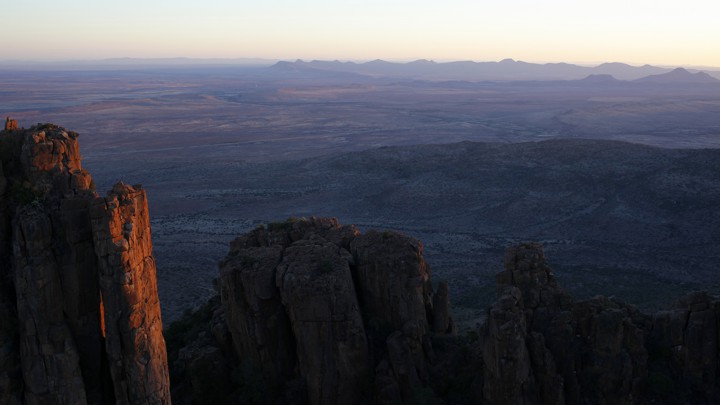
But the most striking feature of this early age of mammals is that it was almost unbelievably hot, so hot that around 50 million years ago there were crocodiles, palm trees, and sand tiger sharks in the Arctic Circle. On the other side of the blue-green orb, in waters that today would surround Antarctica, sea-surface temperatures might have topped an unthinkable 86 degrees Fahrenheit, with near-tropical forests on Antarctica itself. There were perhaps even sprawling, febrile dead zones spanning the tropics, too hot even for animal or plant life of any sort.
“You put more CO2 in the atmosphere and you get more warming, that’s just super-simple physics that we figured out in the 19th century,” says David Naafs, an organic geochemist at the University of Bristol. “But exactly how much it will warm by the end of the century, we don’t know. Based on our research of these ancient climates, though, it’s probably more than we thought.”
Last week, Naafs and colleagues released a study in Nature Geoscience that reconstructs temperatures on land during this ancient high-CO2 hothouse of the late Paleocene and early Eocene epochs—the sweltering launch to the age of mammals. And the temperatures they unearthed are unsurprisingly scorching.
To study Earth’s past, scientists need good rocks to study, and fortunately for geologists and fossil-fuel companies alike, the jungles and swamps of this early age of mammals left behind lots of coal. The Powder River Basin in the United States, for instance, is filled with fossil Paleocene swamplands that, when burned today, contribute about 10 percent of U.S. carbon emissions. Naafs’ team studied examples of lower-quality coals called lignites, or fossilized peat. They had been collected around the world (everywhere from open-pit coal mines in Germany to outcrops in New Zealand), and spanned the late-Paleocene and early-Eocene epochs, from around 56 to 48 million years ago. They were able to reverse engineer the ancient climate by analyzing temperature-sensitive structures of lipids produced by fossil bacteria and archaea living in these bygone wetlands, and preserved for all time in the coal. The team found that, under this past regime of high CO2, in the ancient U.K., Germany, and New Zealand, life endured mean annual temperatures of 23–29 degrees Celsius (73–84 degrees Fahrenheit) or 10–15 degrees Celsius (18–27 degrees Fahrenheit) warmer than modern times.
“These wetlands looked exactly how only tropical wetlands look at present, like the Everglades or the Amazon,” Naafs says. “So Europe would look like the Everglades and a heat wave like we’re currently experiencing in Europe would be completely normal. That is, it would be the everyday climate.”
That modern European heat wave has, in recent weeks, sent sunbathing Scandinavians and reindeer to the beach in temperatures topping 90 degrees Fahrenheit in the Arctic Circle. It has also ignited devastating wildfires across Greece and triggered an excruciating weekend for Spain and Portugal. But over 50 million years ago this would have been the baseline from about 45 to 60 degrees latitude. Under this broiling regime, with unprecedented heat as the norm, actual heat waves might have begun to take on an unearthly quality.
“Perhaps a heat wave in Europe would be something like 40 degrees Celsius (104 degrees Fahrenheit) for three weeks. We don’t know.” So that was life in the late Paleocene and early Eocene in the high mid-latitudes. But closer to the equator in this global sweat lodge, the heat might have been even more outrageous, shattering the limits of complex life. To see exactly how hot, Naafs’ team also analyzed ancient lignite samples from India, which would have been in the tropics at the time—that subcontinent still drifting across the Indian Ocean toward its eventual mountain-raising rendezvous with Asia. But unfortunately, the temperatures from these samples were maxed out. That is, they were too hot for his team to measure by the new methods they had developed. So it remains an open question just how infernal the tropics became in these early days of our ancestors, but some computers tasked with recreating this planet spit out the stuff of science fiction.
“Some climate models suggest that the tropics just became a dead zone with temperatures over 50 degrees Celsius (122 degrees Fahrenheit) like in Africa and South America,” says Naafs. “But we have no data so we don’t know.”
Naafs’ work fits into a larger developing picture of Earth as an almost unrecognizable greenhouse planet of the distant past. University of Colorado paleontologist Jaelyn Eberle recently returned to her office in Boulder from Ellesmere Island, in the Canadian High Arctic, where she’s been doing research since the 1990s. Ellesmere is as far north as you can get before you fall off North America and run into Père Noël drifting over pack ice. Here, featureless highlands overlook ice-choked fjords and a lone Peary’s caribou might mingle with a dozen musk oxen under a vast Nunavut sky. There are also polar bears, but Eberle luckily hasn’t had any run-ins so far—though perspective can play tricks on you at the top of the world, and a snow-white artic hare on its hind legs at the appropriate distance can appear threatening enough.
“You pick up your gun and get all nervous and worried and then look through your binoculars ... It’s just a rabbit,” says Eberle.
But Eberle isn’t venturing this far north just for the occasional hair-raising encounter with polar wildlife. Her target is warmer-weather fauna. Though there are no trees here at the top of the world, there are tree stumps. And they are around 50 million years old.
“The fossil forests on Ellesmere are spectacular,” Eberle says about the ecosystem entombed in the arctic soils. “You start really looking into them and you go, ‘Wow. We are dealing with a rainforest.’”
Eberle is a vertebrate paleontologist and though there’s the aforementioned odd musk ox passing by her camp to consider, in the rocks below she has her pick of animals to study.
“You’ve got alligators, giant tortoises, primates, things like that. We have these big hippo-like animals called Coryphodon. You have tapirs—so you’ve got tapirs living pretty close to the North Pole in the early Eocene, which today—clearly tapirs are not at the North Pole,” she says, laughing.
The presence of these animals suggests a very warm world indeed. And yet, there is a seeming disconnect, between traditional projections for future warming—like those made by the International Panel on Climate Change (IPCC), which predicts around 4 degrees Celsius (7 degrees Fahrenheit) of warming by the end of the century under a business-as-usual emissions scenario (still frightening) and sea-level rise measured in mere inches (still frightening)—and the scarcely recognizable Earths buried in the rocks and created under similar CO2 regimes, like those that Eberle unearths.
One obvious way to reconcile this disparity is by noticing that the changes to the ancient earth took place over hundreds-of-thousands to millions of years and (IPCC graphs notwithstanding) that time won’t stop at the end of the 21st century. The changes that we’ve already set in motion, unless we act rapidly to countervail them, will similarly take millennia to fully unfold. The last time CO2 was at 400 ppm (as it is today) was 3 million years ago during the Pliocene epoch, when sea levels were perhaps 80 feet higher than today. Clearly the climate is not yet at equilibrium for a 400-ppm world.
And it won’t be for quite some time. And anyway, we’re clearly not content to stop at just 400 ppm. If we do, in fact, push CO2 up to around 1,000 ppm by the end of the century, the warming will persist and the earth will continue to change for what, to humans, is a practical eternity. And when the earth system finally does arrive at its equilibrium, it will most likely be in a climate state with no analog in the short evolutionary history of Homo sapiens. Most worryingly, the climate models that we depend on as a species to predict our future have largely failed to predict our sultry ancient past. And though the gulf is narrowing, and models are catching up, even those that come close to reproducing the hothouse of the early Eocene require injecting 16 times the modern level of CO2 into the air to achieve it—far beyond the rather meager doubling or tripling of CO2 indicated by the rock record.
Clearly we are missing something, and Naafs thinks that one of the missing ingredients in the models is methane, a powerful greenhouse gas which might help close the divide between model worlds and fossil worlds.
“We know nothing about the methane cycle during these greenhouse periods,” he says. “We know the hotter it gets the more methane comes out of these wetlands, but we know nothing about the methane cycle beyond the reach of ice cores which only goes back 800,000 years ... We know tropical wetlands pump much more methane into the atmosphere compared to [cooler] wetlands. And we know methane can actually amplify high-latitude warming, so maybe that’s some of the missing feedback.”
In many ways these ancient worlds are not analogs to our own. We have to be careful when making comparisons between the two. The early age of mammals was a different world. The continents were in slightly different positions, leading to a vastly different ocean circulation and boundary conditions quite unlike our own world, 50 million years on—with all the tectonic, oceanographic, and biological changes that come with such a yawning expanse of time. But artificially jam enough greenhouse gases into the atmosphere and Naafs thinks that many of the wildest features of the early age of mammals could be recreated.
“If we were to burn all the fossil fuels and wait a few centuries we might return to this,” he says. “Basically every type of paleoclimate research that’s being done shows that high CO2 means that it’s very warm. And when it gets very warm, it can be really, really, really warm.”
We want to hear what you think about this article. Submit a letter to the editor or write to letters@theatlantic.com.
